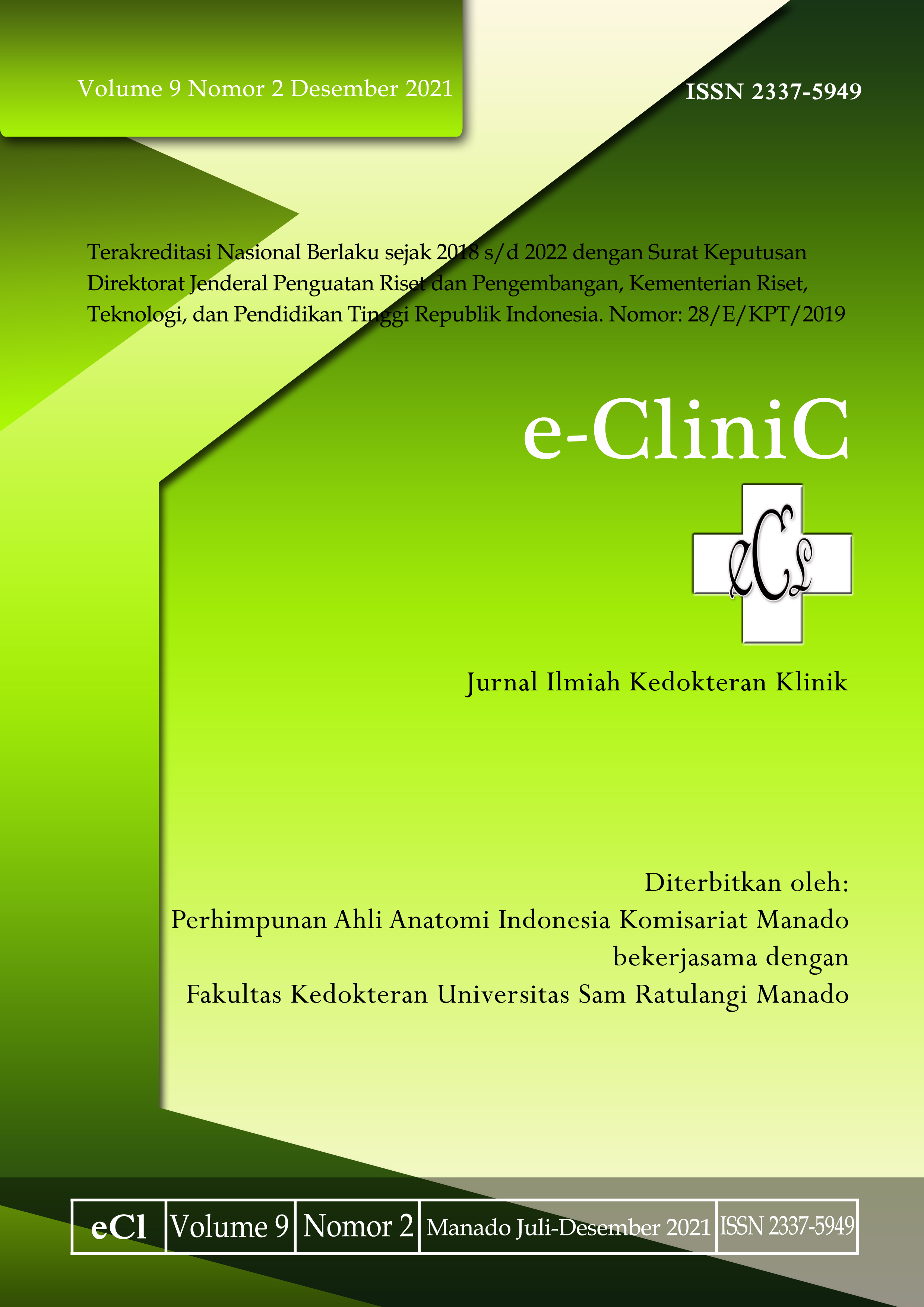Sensitivitas dan Spesifisitas Pain, Incentive Spirometry, Cough Score sebagai Prediktor Acute Respiratory Distress Syndrome pada Pasien dengan Patah Tulang Iga akibat Trauma Tumpul Toraks
DOI:
https://doi.org/10.35790/ecl.v9i2.34508Abstract
Abstract: Thoracic trauma is one of the most common causes of death in trauma cases due to acute respiratory distress syndrome (ARDS). Definitive diagnosis and rapid identification are challenges in ARDS due to blunt thoracic trauma. The PIC score (pain, incentive spirometry, cough) is used to evaluate and monitor patients during treatment. This study was aimed to assess the specificity and sensitivity of the PIC Score in predicting the occurrence of ARDS in patients with rib fractures due to blunt thoracic trauma. This study used a prospective cohort design with a correlation analysis using data of dependency modeling via R-line copula, ROC curve analysis, and regression analysis. The results showed a total of 25 patients with an average age of 52 years, male sex was predominant (84% vs 16%). On admission, most patients had fractures of three ribs (40%). The PIC score tended to be lower in patients with higher number of rib fractures. The relationship between the PIC score and the PaO2/FiO2 ratio on day 7th of treatment showed a positive correlation, supporting the possibility of using the PIC score to predict ARDS. The sensitivity and specificity of the PIC score in predicting ARDS in blunt thoracic trauma were quite high (sensitivity 80.2% and specificity 80.9%) with an accuracy of 80.9%. In conclusion, the PIC score can predict accurately the occurrence of ARDS in patients with rib fractures due to blunt thoracic trauma.
Keywords: blunt thoracic trauma; ARDS; PIC score
 Â
Abstrak: Trauma toraks merupakan salah satu penyebab kematian terbanyak dalam kasus trauma acute respiratory distress syndrome (ARDS). Diagnosis pasti dan identifikasi segera merupakan tantangan dalam penanganan ARDS akibat trauma tumpul toraks. PIC score (pain, incentive spirometry, cough) digunakan untuk mengevaluasi dan memonitor pasien selama perawatan. Penelitian ini bertujuan untuk menilai spesifisitas dan sensitivitas PIC score dalam memrediksi terjadinya ARDS pada pasien patah tulang iga akibat trauma tumpul toraks. Pada penelitian ini digunakan rancangan prospective cohort dengan penilaian korelasi analisis menggunakan data hasil pemodelan dependensi via R-line copula, analisis kurva ROC, dan analisis regresi. Hasil penelitian mendapatkan total 25 pasien dengan rerata usia 52 tahun, didominasi oleh laki-laki (84% vs 16%). Saat masuk kebanyakan pasien mengalami patah tulang pada tiga tulang iga (40%). PIC score cenderung lebih rendah pada pasien dengan jumlah patah tulang iga yang lebih banyak. Hubungan antara PIC score dan rasio PaO2/FiO2 pada hari ke-7 perawatan menunjukkan adanya korelasi positif; hal ini mendukung kemungkinan penggunaan PIC score untuk memrediksi ARDS. Sensitivitas dan spesifisitas PIC score dalam memrediksi ARDS pada trauma tumpul toraks cukup tinggi (sensitivitas 80,2% dan spesifisitas 80,9%) dengan akurasi 80,9%. Simpulan penelitian ini ialah PIC score dapat memrediksi terjadinya ARDS secara akurat pada pasien patah tulang iga akibat trauma tumpul toraks.
Kata kunci: trauma tumpul toraks; ARDS; PIC score
Downloads
Additional Files
Published
How to Cite
Issue
Section
License
COPYRIGHT
Authors who publish with this journal agree to the following terms:
Authors hold their copyright and grant this journal the privilege of first publication, with the work simultaneously licensed under a Creative Commons Attribution License that permits others to impart the work with an acknowledgment of the work's origin and initial publication by this journal.
Authors can enter into separate or additional contractual arrangements for the non-exclusive distribution of the journal's published version of the work (for example, post it to an institutional repository or publish it in a book), with an acknowledgment of its underlying publication in this journal.
Authors are permitted and encouraged to post their work online (for example, in institutional repositories or on their website) as it can lead to productive exchanges, as well as earlier and greater citation of the published work (See The Effect of Open Access).







